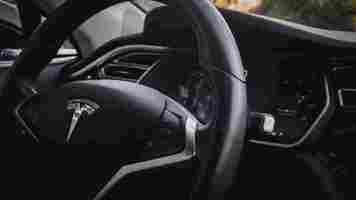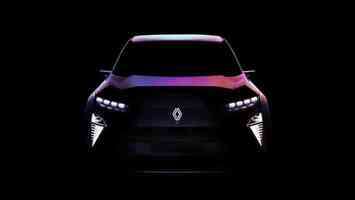Fatal Tesla crash mystery intensifies: Was there a driver behind the wheel?
A preliminary report released on Monday by the National Transportation Safety Board (NTSB) continues the mystery over what actually happened to cause the recent fatal Tesla car crash in Texas.

According to the agency, video footage from the car owner’s home shows the owner entering the Model S’ driver’s door, and his companion the passenger side door.
But whether the driver remained behind the wheel during the tragic ride or not… still is unknown.
After traveling approximately 168 meters, the car left the road on a curve, drove over the curb, and hit a drainage culvert, a raised manhole, and a tree, NTSB’s report says.
The impact damaged the vehicle’s lithium-ion battery, where the devastating fire started. The fire ruined the onboard storage device located in the Model S’ infotainment console. It also compromised the restraint control module, which stores data related to the car’s speed, acceleration, belt status, and airbag deployment.
Unfortunately, this means that important information required to shed light into the accident can’t be easily – or at all – recovered.
This adds to the overall speculations on whether Autopilot was engaged or not and, therefore, potentially responsible for the crash.
Notably, the NTSB tested a similar Model S on the crash site to determine the Autopilot’s function. The results showed that the Traffic Aware Cruise Control (or Adaptive Cruise Control) system could have been engaged, but that Autosteer wouldn’t work on that part of the road.
This coincides with Tesla VP Lars Moravy’s comments , who admitted that at least one of Autopilot’s features – the same one as indicated by the NTSB – was on before the crash occurred.
The NTSB emphasized that “all aspects of the crash remain under investigation.”
Do EVs excite your electrons? Do ebikes get your wheels spinning? Do self-driving cars get you all charged up?
Then you need the weekly SHIFT newsletter in your life. Click here to sign up .
Renault keeps the hydrogen dream alive in France
Last week, French automaker Renault released a sneak preview of a hydrogen-powered car.

We don’t know that much about the car yet. Any car can look good with a few sexy neon lights and a dark backdrop.
More news will come in May, but we have no real way of knowing if the concept car will even make it to market.


But it’s important to not simply dismiss the idea out of hand, and here’s why:
Not Renault’s first rodeo
Firstly, this is not the company’s first foray into hydrogen fuel cell electric vehicles (FCEVs). In 2019, the company announced plans to add hydrogen to two of its light electric commercial vehicles.
Just a refresher: FCEVs operate with a fuel cell, which combines hydrogen from their tanks with oxygen from the air to produce electricity (to power an electric motor). The only emission is water.
But Renault is doing something different. The Renault Kangoo ZE Hydrogen and Renault Master Z.E. Hydrogen use hydrogen for extended range, not as the sole source of battery power.
According to the company, the hydrogen fuel cell provides additional energy for up to three times more range than 100% electric vehicles, with a charging time of only five to 10 minutes.
Its target market is specifically business fleets, especially those already in possession of a hydrogen fueling station or those who drive a regular route which includes access to a suitable refill station.
Can hydrogen fuel cells catch up to EV innovation?
Last year, José Muñoz, chief operating officer for Hyundai, commented that hydrogen technology is about where battery vehicles were in the early 2010s.
The company predicts that its fuel cells will reach cost parity with electric vehicle batteries by 2030. Geez, that’s a lot of catching up to do.
Despite that, Hyundai aims to become the first automaker to apply fuel cell systems to all commercial vehicle models by 2028.
One of the biggest barriers to commercializing hydrogen has been the lack of sustainable green steel and green hydrogen . Currently, over 95% of the hydrogen available is produced using fossil fuels — clearly counterintuitive to its reputation as a carbon-friendly form of energy.
Further, we don’t know if Renault’s concept car is an all-hydrogen or extended range.
But, we won’t see a Renault hydrogen-powered car without adequate infrastructure. For reference, all of France has less than 20 public charging stations in operation.
By comparison, there are over 30,000 EV charging stations across the country. It makes the idea of extended range seem rather irrelevant.
And what’s more, you can’t refuel a hydrogen car at home at night.
But France is investing big
Fortunately, Renault is putting even more effort behind its hydrogen-powered ambitions.
In 2021, the company announced a partnership with Plug Power on an enterprise called HYVIA . It focuses on vehicle R&D and refueling stations. Plug Power has deployed over 40,000 fuel cell systems and designed and built 110 refueling stations.
After less than six months of existence, the HYVIA has unveiled three hydrogen light commercial vehicles: a van, a chassis cab, and a city bus. The vehicles will be available in 2022 with green hydrogen production and distribution solutions. I t’s a great start.
And, for broader context, France has been betting big on hydrogen since launching a national plan in June 2018. It aims to have 400 to 1,000 hydrogen stations by 2028. Okay, the numbers look woeful compared to EV chargers, but still.
Hydrogen taxis have hit the streets
There’s even a taxi company called HYPE , the world’s first mobility company to develop a commercial fleet of hydrogen-powered taxis. Since their 2015 founding, they’ve already transported over a million passengers in France.
The company plans to deploy 10,000 Hype taxis and 20 stations powered by locally produced green hydrogen in the Paris region, and expand to 15 additional cities by late 2024.
Can good intentions translate to commercial success?
So, when we talk about hydrogen , we’re never short of plans or good intentions. It’s putting these into practice that is taking a long time – and a lot of money.
And, if we look at the auto industry delays of the last two years, FCEVs have A LOT of catching up to do. I want them to catch up. I want ALL of the alternative energy sources to succeed — electric, hydrogen, solar, and whatever comes next. It’s the waiting that I hate.
Toyota unveils three-wheeled escooter for walking areas — Segway style
As of October 1, the Japanese automaker has launched its C + walk electric scooter, designed to help people in walking areas both indoors and outdoors.

It’s a standing-type model that slots into the C + walk walking-area mobility series, which will also include seated-type and wheelchair-linked-type vehicles.
A removable lithium-ion battery allows the C + walk to travel about 14km on a single charge, and it needs some 2.5 hours to recharge from zero to full.


Users can set the scooter’s maximum traveling speed via a speed adjustment switch, and can choose between five different options, ranging from 2 to 6km/h, with an additional 10km/h setting for experienced users.
The vehicle takes up a similar amount of space as a single person, while it’s equipped with obstacle detection functions that help avoid collisions with obstacles or pedestrians ahead.
Toyota has designed the C + walk for comfortable use in walking areas, side-by-side travel, and communication with fellow pedestrians.
Initially, the automaker envisions the scooter helping elderly workers travel across large-scale facilities such as warehouses, factories, and airport terminals. It could also be used on activity tours taking place inside parks and other facilities.
In the future, the company hopes the Japanese government will certify the C + walk for use on public roads (under existing laws it’s not permitted on public streets or sidewalks), in which case it would support people who find it hard to walk long distances.
Overall, it seems that Toyota is trying to pick up where Segway PT, the two-wheeled, self-balancing personal transporter, left off.
Although the vehicle never realized its creators’ world-changing ambitions and stopped being produced in 2020, it did leave a legacy behind it that now Toyota, among other companies, is eyeing.
Regardless of what the future holds for the C + walk, it’s currently offered only in Japan starting at ¥341,000, or just under $3,100.
Do EVs excite your electrons? Do ebikes get your wheels spinning? Do self-driving cars get you all charged up?
Then you need the weekly SHIFT newsletter in your life. Click here to sign up .